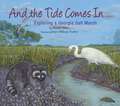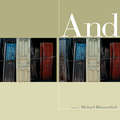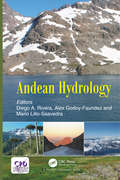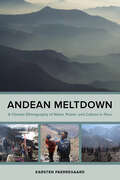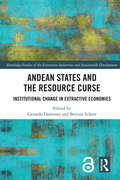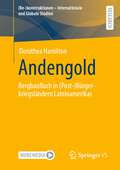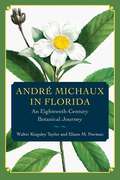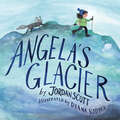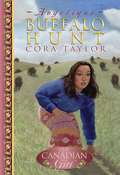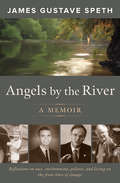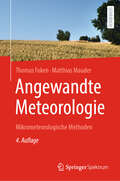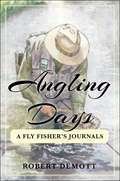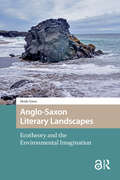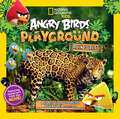- Table View
- List View
And the Tide Comes In...: Exploring a Georgia Salt Marsh
by Merryl AlberThis book is a narrative told from the point of view of a young girl who is showing her visiting cousin a Georgia coastal salt marsh. The children visit the marsh every day for four days, slowly building their knowledge of the ecosystem. As they make their way through the tall marsh grass, the two children slip and slide on marsh mud, discover clusters of ribbed mussels at the base of the grass, and watch as fiddler crabs skitter from burrow to burrow around the edge of a creek. Representative of intertidal marshes throughout the world, the Georgia coastal salt marsh described in this book is typically shared by both land and marine mammals, presenting a unique ecosystem at the water's edge.
And: Life And Loathing In Greater Israel (American Poets Continuum)
by Michael BlumenthalThrough Michael Blumenthal&’s eyes we gain a renewed, childlike wonder at everything from plants, trees, and relationships to the most fundamental word in our vocabulary: AND. Blumenthal uses the conjunction to unify this collection and create a chanting, sonorous rhythm to his work. The result is a book of poems-as-hymns-and-praises.Michael Blumenthal holds the Mina Hohenberg Darden Endowed Chair in Creative Writing at Old Dominion University. His other books include the memoir All My Mothers and Fathers (HarperCollins Publishers, 2002), and the poetry collection Dusty Angel (BOA Editions, Ltd., 1999), for which he was awarded the Isabella Gardner Poetry Award. Blumenthal&’s new collection of poems, titled &“And,&” is the closest that the stoicism of Ecclesiastes will come to getting a 21st-century makeover. In it, there&’s a time to laugh and cry, scatter stones and gather them up, and all the rest. There&’s no point, though, in toil and hope beyond that. After reading these poems, which are designed with a cosmic sweep, you get the feeling that Blumenthal&’s plan is, as in Dylan Thomas&’s poem, eventually just to go gentle into that good night: &“Rage, rage against the dying of the light&” be damned.--THE JEWISH DAILY FORWARDMichael Blumenthal&’s stunning new book, And, is an Eliotic celebration of life in the world as continuum and progress. He achieves this through a simple and seductive meditation upon the conjunction, &“and,&” and the way it enriches the complexity of language as it shapes lived experience.--The Montserrat Review
Andean Hydrology
by Diego A. Rivera Alex Godoy-Faundez Mario Lillo SaavedraThis book describes the ecosystem of the Andean watersheds, covering the Californian valley, tropical Andes, and southern Andes. Case studies of the new methods and techniques used for hydrological research in the Andes are provided, and sustainability issues pertaining to Andean water resources are discussed in the context of climate change, social and economic issues, and public policy. Furthermore, the impact of economic development on the Andean ecosystem, specifically the effect on the water cycle and the water-energy-food nexus, are examined.
Andean Meltdown: A Climate Ethnography of Water, Power, and Culture in Peru
by Karsten PaerregaardAndean Meltdown examines how climate change and its consequences for Peru's glaciers are affecting the country's water supply and impacting Andean society and culture in unprecedented ways. Drawing on forty years of extensive research, relationship building, and community engagement in Peru, Karsten Paerregaard provides an ethnographic exploration of Andean ritual practices and performances in the context of an altered climate. By documenting Andean peoples' responses to rapid glacier retreat and urgent water shortages, Paerregaard considers the myriad ways climate change intersects with environmental, social, and political change. A pathbreaking contribution to cultural anthropology and environmental humanities, Andean Meltdown challenges prevailing theoretical thinking about the culture-nature nexus and offers a new perspective on Andean peoples' understanding of their role as agents in the shifting relationship between humans and nonhumans.
Andean States and the Resource Curse: Institutional Change in Extractive Economies (Routledge Studies of the Extractive Industries and Sustainable Development)
by Gerardo Damonte Bettina SchorrThis volume explores institutional change and performance in the resource-rich Andean countries during the last resource boom and in the early post-boom years. The latest global commodity boom has profoundly marked the face of the resource-rich Andean region, significantly contributing to economic growth and notable reductions of poverty and income inequality. The boom also constituted a period of important institutional change, with these new institutions sharing the potential of preventing or mitigating the maladies extractive economies tend to suffer from, generally denominated as the “resource curse”. This volume explores these institutional changes in the Andean region to identify the factors that have shaped their emergence and to assess their performance. The interdisciplinary and comparative perspective of the chapters in this book provide fine-grained analyses of different new institutions introduced in the Andean countries and discusses their findings in the light of the resource curse approach. They argue that institutional change and performance depend upon a much larger set of factors than those generally identified by the resource curse literature. Different, domestic and external, economic, political and cultural factors such as ideological positions of decision-makers, international pressure or informal practices have shaped institutional dynamics in the region. Altogether, these findings emphasize the importance of nuanced and contextualized analysis to better understand institutional dynamics in the context of extractive economies. This book will be of great interest to students and scholars of the extractive industries, natural resource management, political economics, Latin American studies and sustainable development.
Andengold: Bergbaufluch in (Post-)Bürgerkriegsländern Lateinamerikas ((Re-)konstruktionen - Internationale und Globale Studien)
by Dorothea HamiltonDer 2016 unterschriebene Friedensvertrag mit FARC in Kolumbien stellt das Land u.a. vor die Frage, welche Bedeutung der Ressourcenreichtum des Landes für den Aufbau einer friedlichen Gesellschaft spielen soll. Abgeleitet von den Erkenntnissen aus Peru wird untersucht, welchen Einfluss der legale und nicht legale Abbau von Gold auf die jeweiligen bewaffneten Konflikte hatte, wie sich deren Nutzung in der Friedenszeit wandelte und welche neuen Konflikte entstanden sind. Zum Umgang mit der ehemaligen Konfliktressource Gold gibt es divergierende Vorstellungen, die extraktivistischen und postextraktivstischen Ideen zugeordnet werden können, die in lokalen Konflikten enden. Der Fokus liegt auf der subnationalen, nach Abbauart differenzierten Untersuchung von Ressourcenausbeutung und Bürgerkrieg bzw. Postbürgerkrieg. Die Ergebnisse zu illegalem Bergbau zeigen, dass es sich dabei nicht um ein Bürgerkriegsphänomen handelt, sondern vielmehr um eine geduldete Praxis, die die Bewaffnung von Gewaltakteuren bedingt. Aber auch legale Ressourcenförderung, die nach Beendigung des Konflikts als Strategie der Friedensfinanzierung verstanden wird, führt zu ähnlichen negativen Auswirkungen, sodass von einem Bergbaufluch gesprochen wird.
André Michaux in Florida: An Eighteenth-Century Botanical Journey
by Walter Kingsley Taylor Eliane M. NormanRetracing the eighteenth-century Florida exploration of botanist Andre Michaux The name Michaux often appears in the plant names of Florida, from the endangered yellow violets that grow wild in the panhandle to the Florida rosemary of the scrub. Andre Michaux (1746-1803) was one of the most extraordinary and dynamic individuals of early explorations in North America and the first trained botanist to explore extensively the wilderness east of the Mississippi River, including Spanish East Florida. This first book-length account of Michaux's Florida exploration combines his original journal with writings about him by later authors, historical background, and the author's own narrative to create a multifaceted, comprehensive treatise on Michaux's travels and discoveries in Florida.Beginning with a biographical sketch on the life of Andre Michaux, royal botanist for King Louis XVI of France, the authors retrace (using 16 maps) the exploratory routes he took in Florida and recount historical events occurring in Florida at the time. They include in full documentary form all the plants he discovered, collected, and observed and fully assess his findings so that his contributions can now be evaluated along with those of better-known botanists of whom much has been written, such as John Bartram and his son William--who acknowledged the Frenchman's abilities, writing that Michaux could traverse the same ground that he and his father had covered and find plants that they had missed.From a historical as well as a botanical perspective, Andre Michaux in Florida re-creates the Florida exploration of a remarkable explorer and observer and allows us to experience vicariously the vibrancy and joy of his journey of discovery.
Angela's Glacier
by Jordan ScottAward-winning author Jordan Scott&’s luminously-illustrated love story of a girl growing up in the shadow of a glacier that&’s always there to listen.Angela listened to the glacier; the glacier listened to Angela.As soon as she&’s born, Angela&’s father introduces her to her glacier. He carries her on his back up the icy expanse as the wind makes music of the snow and the water underneath. Over time, Angela gets big enough to walk beside him, and then, to go alone. She tells her glacier everything, and it answers. But then, life gets busy. Angela&’s days fill up with school, homework, violin and soccer and friends. Until one day, Angela&’s heart doesn&’t sound right anymore. Luckily, Angela&’s dad is there to remind her what she needs: a visit to her ancient icy friend.From the Schneider Family and Boston Globe-Horn Book Award-winning author of I Talk Like a River, Angela&’s Glacier is a moving story about growing up without losing yourself, loving nature, and allowing it to love you in return. Diana Sudyka&’s breathtaking artwork pulls the reader into a world of warm hugs from shining blue-green ice— and from dad, too.
Angelique #1: Buffalo Hunt (Our Canadian Girl)
by Cora TaylorBuffalo Hunt is set in the West, during the waning years of the buffalo hunt. Angelique Dumas is a ten-year-old Métis girl, and this year she gets to be part of the hunt-- not with the children, but with the grown-ups.
Angels by the River: A Memoir
by James Gustave SpethAngels by the River follows James Gustave Speth’s unlikely path—from a Southern boyhood to his career as an influential mainstream environmentalist to his current system-changing activism. In this compelling memoir, Speth explores the issues, and realities, that have shaped the nation since the 1950s, and that turned an “ultimate insider” into someone willing to be arrested in front of the White House. Born and raised in a town where both the best and worst of the South shone through—a town that eventually became the scene of South Carolina’s horrific Orangeburg Massacre—Speth explores how the civil rights movement and the South’s agrarian roots influenced his academic career at Yale and later work in the heyday of the environmental movement, when he helped launch two landmark and influential environmental groups—the Natural Resources Defense Council and the World Resources Institute—advise the White House on climate and other emerging issues, and lead the UN’s development efforts around the globe. Speth fought to create and uphold the nation’s toughest environmental laws, but now believes a new environmentalism is needed to confront today’s challenges. The advancing climate crisis cannot be addressed, he warns, as long as we remain fixated on endless growth and consumption, corporate profits, increasing the incomes of the well-to-do, neglecting those just getting by, and helping abroad only modestly. An American tale, in all its complexity, Speth’s memoir is an inspiration—especially for readers contemplating how to make a difference in an increasingly complex world.
Angewandte Meteorologie: Mikrometeorologische Methoden
by Thomas Foken Matthias MauderGegenstand des Buches sind die atmosphärischen Vorgänge im unmittelbaren Lebensraum des Menschen, also in den unteren 100 –1000 Metern der Atmosphäre und in Gebieten mit nur einigen Kilometern Ausdehnung. Dieser mikrometeorologische Raum wird in Büchern der allgemeinen Meteorologie nur wenig berücksichtigt. Damit bietet das Buch Grundlagen insbesondere für angewandte meteorologische Fachgebiete wie Biometeorologie, Agrarmeteorologie, Hydrometeorologie, Umweltmeteorologie und technische Meteorologie sowie für die Biogeochemie. Ein wichtiger Schwerpunkt sind dabei die Transportprozesse und Stoffflüsse zwischen Atmosphäre und Erdoberfläche, wobei bewachsene und heterogene Unterlagen eine besondere Beachtung finden.Die Autoren behandeln die Teilgebiete Theorie, Messtechnik, experimentelle Verfahren und Modellierung so, dass sie jeweils auch eigenständig für Lehre, Forschung und Praxis genutzt werden können.Neuerungen gegenüber der dritten Auflage sind Aktualisierungen und kleinere Ergänzungen in allen Kapiteln sowie ausgewählte inhaltliche Erweiterungen unter Berücksichtigung der Fragen des Klimawandels.
Angling Days: A Fly Fisher's Journals
by Robert DeMott“From the very first, it seems, fishing was a respite and a therapy along with all of its other potentially redemptive qualities.” —Robert DeMott Spanning more than forty-five years, Angling Days is a collection of Robert DeMott’s numerous journal entries, each a small essay in itself, jotted down during the placid moments of fishing in and along the streams and rivers of North America. Through his journaling, DeMott carries on the angling tradition of channeling the tranquility of fly fishing into creative endeavors, whether by painting, sketching, fly tying, or writing. For him, it was writing—something he did whenever he could, whether in the midst of fishing or during a break away from the water.Angling Days is a lifetime of work, a chronicle of what it is to be an angler seeking the most pristine waters and the smartest fish. It is a collection of entries and musings in the vein of DeMott’s literary hero, Henry David Thoreau, and promises to shine a new light on the art and joy of fly fishing.
Anglo-Saxon Literary Landscapes: Ecotheory and the Environmental Imagination (Environmental Humanities in Pre-modern Cultures)
by Heide EstesLiterary scholars have traditionally understood landscapes, whether natural or manmade, as metaphors for humanity instead of concrete settings for people's actions. This book accepts the natural world as such by investigating how Anglo-Saxons interacted with and conceived of their lived environments. Examining Old English poems, such as Beowulf and Judith, as well as descriptions of natural events from the Anglo-Saxon Chronicle and other documentary texts, Heide Estes shows that Anglo-Saxon ideologies which view nature as diametrically opposed to humans, and the natural world as designed for human use, have become deeply embedded in our cultural heritage, language, and more.
Angry Birds Playground: A Forest Floor to Treetop Adventure
by Jill EsbaumFollow along with your favorite Angry Birds characters as they go on an incredible adventure through the rain forest. Kids will be hooked on a wacky mission to learn all about the rain forest so they can protect it from those bad piggies. Readers analyze and explore the most diverse ecosystem in the world as they build basic skills. Packed with learning exercises and fun activities, Angry Birds Playground: Rain Forest will transform kids into adventurers and leave them wanting more. It's a fun-tastic way to learn about a habitat in danger and the tens of thousands of creatures that call it home!
Anima: A Wild Pastoral
by Kapka KassabovaIn Anima, Kapka Kassabova introduces us to the “pastiri” people—the shepherds struggling to hold on to an ancient way of life in which humans and animals exist in profound interdependence. Following her three previous books set in the Balkans, and with an increasinging interest in the degraded state of our planet and culture, Kassabova reaches further into the spirit of place than she ever has before. In this extraordinary portrayal of pastoral life, she investigates the heroic efforts to sustain the oldest surviving breeds of our domesticated animals, and she shows us the epic, orchestrated activity of transhumance—the seasonal movement, on foot, of a vast herd of sheep, working in tandem with dogs. She also becomes more and more attuned to the isolation and sacrifices inherent in the lives shaped by this work.Weaving together lyrical writing about place with a sweeping sense of the traumatic histories that have shaped this mountainous region of Bulgaria, Kassabova shows how environmental change and industrial capitalism are endangering older, sustainable ways of living, and by extension she reveals the limited nature of so much of modern life. But shining through Kassabova’s passionate, intimate response to the monoculture that is “Anthropos” is her indelible portrait of a circulating interdependence of people and animals that might point to a healthier way to live.
Animal Behavior Desk Reference: A Dictionary of Animal Behavior, Ecology, and Evolution, Third Edition
by Edward M. Barrows"Words are our tools, and, as a minimum, we should use clean tools. We should know what we mean and what we do not, and we must forearm ourselves against the traps that language sets us." -- The Need for Precise Terminology, Austin (1957, 7-8) It follows that, for effective and efficient communication, people should have, or at least understand, th
Animal Behavior and Wildlife Conservation
by Marco Apollonio Marco Festa-BianchetEfforts to conserve wildlife populations and preserve biological diversity are often hampered by an inadequate understanding of animal behavior. How do animals react to gaps in forested lands, or to sport hunters? Do individual differences--in age, sex, size, past experience--affect how an animal reacts to a given situation? Differences in individual behavior may determine the success or failure of a conservation initiative, yet they are rarely considered when strategies and policies are developed. Animal Behavior and Wildlife Conservation explores how knowledge of animal behavior may help increase the effectiveness of conservation programs. The book brings together conservation biologists, wildlife managers, and academics from around the world to examine the importance of general principles, the role played by specific characteristics of different species, and the importance of considering the behavior of individuals and the strategies they adopt to maximize fitness.Each chapter begins by looking at the theoretical foundations of a topic, and follows with an exploration of its practical implications. A concluding chapter considers possible future contributions of research in animal behavior to wildlife conservation.
Animal Behavior: Life in the Wild (DK Definitive Visual Encyclopedias)
by DKA thrilling face-to-face encounter with animals in their own environment—their elaborate displays, intimate lives, and extraordinary behavior. Did you know that elephants give each other names, orangutans self-medicate, and rats giggle? Animal Behavior is full of hundreds of stories that shed light on how animals navigate life in the wild. Packed with vivid wildlife photography and action sequences, every aspect of animal life and behavior is explored and explained – from courtship rituals and birth to hunting and death. An initial overview of animal anatomy and physiology reveals the science and biomechanics that underpin animal behavior, while later chapters thematically break down the intricacies of animal feeding, development, communication, intelligence, learning, and other behavioral characteristics. Learn about play through river otters, see socialization among parrots at the riverbank, and catch prey with a fishing spider. Feature panels throughout the book explore the biology behind these traits, introduce case studies from the field, and highlight critical conservation issues facing these animals. Animal Behavior has been created in collaboration with internationally renowned zoologist and TV presenter Charlotte Uhlenbroek and a team of wildlife experts to ensure up-to-date and accurate information.
Animal Breeding, Welfare and Society
by Jacky TurnerThe determination of when, how, how often and with whom an animal breeds is moving rapidly away from evolutionary pressures and towards human purposes: these include the breeding of around 50 billion mammals and birds for food production annually, the breeding of pedigree dogs and cats, racing dogs and horses, specialised laboratory animal strains and the use of reproductive science to conserve endangered species or breeds and to limit unwanted populations of pests and non-native species. But the ethics and sustainability of this takeover of animals' reproductive lives have been insufficiently examined by either professionals or the public. This book discusses the methods, the motivations and the consequences of human intervention in animal breeding in terms of animal health, behaviour and well-being. It explores where we are now and the choices ahead, and looks to a future where we have more respect for animals as sentient beings and where we could loosen the reins of reproductive control.
Animal Camp: Reflections on a Decade of Love, Hope, and Veganism at Catskill Animal Sanctuary
by Kathy StevensPicking up where she left off in Where the Blind Horse Sings, Kathy Stevens regales us with more tales of the rescued animals at Catskill Animal Sanctuary (CAS), some touching, some hilarious, all provocative. We meet Barbie, the broiler hen found hiding under a blue Honda in Brooklyn who falls for the animal ambassador Rambo, a ram with an uncanny sense of what others need. Then there's Norma Rae, the turkey rescued from a "turkey bowl" just before Thanksgiving. There's also Noah, a twenty-one-year-old stallion, starved and locked in a dark stall for his entire life until he came to the safety and plenty of CAS. Claude, the giant pink free-range pig, is but another of the "underfoot family," those who roam the barnyard, free and with dignity, interacting with their own and other species in startling and profound ways. The love Stevens has for these animals, and the amount of love they give her in return, is stunning and will make any reader more thoughtful of how we treat a whole class of animals in this country. Pigs, cows, chickens, turkeys, horses, goats, sheep, and more, march into CAS and into our hearts as we learn about their quirks and personalities and what makes us human.
Animal City
by Joan NegrescolorNina journeys to a secret jungle city populated by animals, plants, and lost objects. The reason for her visit: story hour, where a book's power holds the wild in thrall. The animals are eager for stories about space, the sea, and other worlds. But their favorite story of all is the one told here: a story about a mysterious place, laden with legend and lore, and now overtaken by nature. Five Pantone colors infuse each illustrated spread with a vibrant, electric energy, making this powerful celebration of nature—and stories—as vivid visually as its narrative is engrossing.
Animal City: The Domestication of America
by Andrew A. RobichaudAmerican urbanites once lived alongside livestock and beasts of burden. But as cities grew, human–animal relationships changed. The city became a place for pets, not slaughterhouses or working animals. Andrew Robichaud traces the far-reaching consequences of this shift—for urban landscapes, animal- and child-welfare laws, and environmental justice.
Animal Climate Heroes
by Alison Pearce StevensIn our left corner we have the meanest villain that’s ever existed. Responsible for rising seas and loss of biodiversity, it’s climate change ready to wreak havoc on the Earth. But in our right corner? We have four superheroes ready to save the day!Forest elephants protect our forests by trampling trees.Whales boost ocean health with their massive poo-nados.Sea otters defend kelp forests from purple invaders.And echidnas bury tons of soil to stop climate change.But we can’t leave them in this fight alone. We need to protect our heroes who, in return, defend our planet. Get ready to learn all about these four legged, and two-flippered, creatures and how YOU can be a climate hero too!
Animal Conservation Ethics and the Population Problem: A Habilitation on Rehabilitation (The Palgrave Macmillan Animal Ethics Series)
by Leif Brostrom DeVaneyIn this book, Leif DeVaney brings the traditional philosophical branches of metaphysics and ethics to bear on conservation biology. While many previous attempts at asking and answering ethical questions related to conservation and other environmentally relevant activities exist, few such attempts have engaged adequately with the &“rock bottom&” approach of metaphysics. Through this metaphysically realistic lens, the ontologicalstatus of the population (as well as other ecological &“wholes&”) is challenged. DeVaney argues that individual nonhuman animals are found to have interests that parallel human interests. These include the biotic goals of survival and reproduction, as well as freedom from undue pain and suffering. From an ethical standpoint, the conclusion differs drastically from the dominant consequentialist contention that the good of some can be sacrificed for the supposed greater good of the many. DeVaney initiates the establishment of the subdiscipline of conservation metaphysics, which naturally leads to a theoretically grounded ethic.
Animal Ethics for Veterinarians (Common Threads)
by Andrew Linzey Clair LinzeyVeterinarians serve on the front lines working to prevent animal suffering and abuse. For centuries, their compassion and expertise have improved the quality of life and death for animals in their care. However, modern interest in animal rights has led more and more people to ask questions about the ethical considerations that lie behind common veterinary practices. This Common Threads volume, drawn from articles originally published in the Journal of Animal Ethics (JAE), offers veterinarians and other interested readers a primer on key issues in the field. Essays in the first section discuss aspects of veterinary oaths, how advances in animal cognition science factor into current ethical debates, and the rise of complementary and alternative veterinary medicine and its relationship to traditional veterinary medicine. The second section continues with an essay that addresses why veterinarians have an obligation to educate animal caregivers to look past "cuteness" in order to treat all animals with dignity. The collection closes with three short sections focusing on animals in farming, trade, and research ”areas where veterinarians encounter conflicts between their job and their duty to advocate and care for animals. Contributors: Judith Benz-Schwarzburg, Vanessa Carli Bones, Grace Clement, Simon Coghlan, Priscilla N. Cohn, Mark J. Estren, Elisa Galgut, Eleonora Gullone, Matthew C. Halteman, Andrew Knight, Drew Leder, Andrew Linzey, Clair Linzey, Kay Peggs, Megan Schommer, Clifford Warwick, and James W. Yeates.
